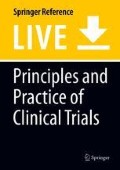Abstract
In a randomized clinical or field trial, when randomization units are comprised of groups of individuals, many aspects of design and analysis differ greatly from those of an individually randomized trial. In this chapter, we highlight those features which differ the most, explaining the nature of the differences and delineating approaches to accommodate them. The focus is on design, as many readers will be familiar with the correlated data analysis techniques that are appropriate for many (although not all) cluster randomized trials (CRTs). Thus, the chapter begins by covering motivations for using a CRT design, basic correlation parameters, the variety of potential estimands, delineation and randomization of clusters, and sample size calculation. This is followed by sections on the analysis and reporting of results, which highlight ways to handle the multilevel nature of the data. Finally, ethical and monitoring considerations unique to CRTs are discussed.
References
Bailey RA (1987) Restricted randomization: a practical example. J Am Stat Assoc 82:712–719
Bailey RA, Rowley CA (1987) Valid randomization. Proc R Soc Lond A Math Phys Sci 410:105–124
Begg C, Cho M, Eastwood S, Horton R, Moher D, Olkin I, Pitkin R, Rennie D, Schulz KF, Simel D, Stroup DF (1996) Improving the quality of reporting of randomized controlled trials. The CONSORT statement. JAMA 276:637–639
Bennett S, Parpia T, Hayes R, Cousens S (2002) Methods for the analysis of incidence rates in cluster randomized trials. Int J Epidemiol 31:839–846
Bruhn M, McKenzie D (2009) In pursuit of balance: randomization in practice in development field experiments. Am Econ J Appl Econ 1:200–232
Campbell MJ, Walters SJ (2014) How to design, analyse and report cluster randomised trials in medicine and health related research. Wiley, West Sussex
Campbell MK, Piaggio G, Elbourne DR, Altman DG, CONSORT Group (2012) Consort 2010 statement: extension to cluster randomised trials. BMJ 345. https://doi.org/10.1136/bmj.e5661
Diehr PD, Martin C, Koepsell T, Cheadle A (1995) Breaking the matches in a paired t-test for community interventions when the number of pairs is small. Stat Med 14:1491–1504
Donner A, Klar N (2000) Design and analysis of cluster randomised trials in health research. Arnold, London
Ebola ça suffit Ring Vaccination Trial Consortium (2015) The ring vaccination trial: a novel cluster randomised controlled trial design to evaluate vaccine efficacy and effectiveness during outbreaks, with special reference to Ebola. BMJ 351. https://doi.org/10.1136/bmj.h3740
Eldridge S, Kerry S (2012) A practical guide to cluster randomised trials in health services research, 1st edn. Wiley, West Sussex
Ferebee SH, Mount FW, Murray FJ, Livesay VT (1963) A controlled trial of isoniazid prophylaxis in mental institutions. Am Rev Respir Dis 88:161–175
Fisher RA (1947) The design of experiments, 4th edn. Hafner-Publishing Company, New York
Halloran ME, Struchiner CJ (1991) Study designs for dependent happenings. Epidemiology 2:331–338
Halloran ME, Struchiner CJ, Longini IM Jr (1997) Study designs for evaluating different efficacy and effectiveness aspects of vaccines. Am J Epidemiol 146:789–803
Hayes RJ, Bennett S (1999) Simple sample size calculation for cluster-randomized trials. Int J Epidemiol 28:319–326
Hayes RJ, Moulton LH (2017) Cluster randomised trials, 2nd edn. Chapman & Hall, Boca Raton
Hussey MA, Hughes JP (2007) Design and analysis of stepped wedge cluster randomized trials. Contemp Clin Trials 28:182–191
Kish L (1965) Survey sampling. Wiley, New York
Kotz D, Spigt M, Arts ICW, Crutzen R, Viechbauer W (2012) Use of the stepped wedge design cannot be recommended: a critical appraisal and comparison with the classic cluster randomized controlled trial design. J Clin Epidemiol 65:1249–1252
Laird NM, Ware JH (1982) Random-effect models for longitudinal data. Biometrics 38:963–974
Li F, Turner EL, Heagerty PJ, Murray DM, Volmer WM, Delong EL (2017) An evaluation of constrained randomization for the design and analysis of group-randomized trials with binary outcomes. Stat Med 36:3791–3806
Liang KY, Zeger SL (1986) Longitudinal data analysis using generalized linear models. Biometrika 73:13–22
Montgomery AA, Peters TJ, Little P (2003) Design, analysis and presentation of factorial randomized controlled trials. BMC Med Res Methodol 3:26. https://doi.org/10.1186/1471-2288-3-26
Morgan KL, Rubin DB (2012) Rerandomization to improve covariate balance in experiments. Ann Stat 40:1263–1282
Moulton LH (2004) Covariate-based constrained randomization of group-randomized trials. Clin Trials 1:297–305
Moulton LH, O’Brien KL, Kohberger R, Chang I, Reid R, Weatherholtz R, Hackell JG, Siber GR, Santosham M (2001) Design of a group-randomized Streptococcus pneumoniae vaccine trial. Control Clin Trials 22:438–452
Murray DM (1998) Design and analysis of group randomised trials. Oxford University Press, New York
Neuhaus JM, Kalbfleisch JD, Hauck WW (1991) A comparison of cluster-specific and population-averaged approaches for analyzing correlated binary data. Int Stat Rev 59:25–35
Raab GM, Butcher I (2001) Balance in cluster randomized trials. Stat Med 20:351–365
Scott JM, deCamp A, Juraska M, Fay MP, Gilbert PB (2017) Finite-sample corrected generalized estimating equation of population average treatment effects in stepped wedge cluster randomized trials. Stat Methods Med Res 26:583–597. https://doi.org/10.1177/0962280214552092
The National Commission for the Protection of Human Subjects of Biomedical and Behavioral Research (1979) Protection of human subjects; Belmont report: notice of report for public comment. Fed Regist 44:23191–23197
Thompson JA, Fielding KL, Davey C, Aiken AM, Hargreaves JR, Hayes RJ (2017) Bias and inference from misspecified mixed-effect models in stepped wedge trial analysis. Stat Med 36:3670–3682
Torgerson D (ed) (2015) Stepped wedge randomized controlled trials. Trials 16:351,353,354,358,352,350,359
Weijer C, Grimshaw JM, Eccles MP, McRae AD, White A, Brehaut JC, Taljaard M, Ottawa Ethics of Cluster Randomized Trials Consensus Group (2012) The Ottawa statement on the ethical design and conduct of cluster randomized trials. PLoS Med 9. https://doi.org/10.1371/journal.pmed.1001346
Xu Z, Kalbfleisch JD (2010) Propensity score matching in randomized clinical trials. Biometrics 66:813–823
Author information
Authors and Affiliations
Corresponding author
Editor information
Editors and Affiliations
Section Editor information
Rights and permissions
Copyright information
© 2020 Springer Nature Switzerland AG
About this entry
Cite this entry
Moulton, L.H., Hayes, R.J. (2020). Cluster Randomized Trials. In: Piantadosi, S., Meinert, C. (eds) Principles and Practice of Clinical Trials. Springer, Cham. https://doi.org/10.1007/978-3-319-52677-5_108-1
Download citation
DOI: https://doi.org/10.1007/978-3-319-52677-5_108-1
Received:
Accepted:
Published:
Publisher Name: Springer, Cham
Print ISBN: 978-3-319-52677-5
Online ISBN: 978-3-319-52677-5
eBook Packages: Springer Reference MathematicsReference Module Computer Science and Engineering

